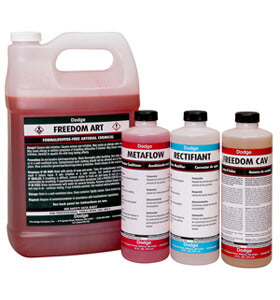Funeral Home OSHA Spill Protection Plan Requirements

Share
We are often asked the question: “Does our funeral home really need a Spill Prevention & Response Program?” For many years, we have been able to respond with “yes, but we can likely avoid activating by classifying your spills as ‘incidental spills.’” Today, that answer is changing, we are seeing more chemicals in gallon containers. Some examples include:
- Dodge DisSpray
- B&G Hy Jell Feature Builder
- Dodge Icterine Dye
- Dodge DSD Disinfectant
- Dodge Action (powder)
- Dodge Viscerarock (powder)
As containers increase in volume, the likelihood of a hazardous spill also increases. As part of our Complete OSHA Compliance Program for Funeral Homes, we are providing all of our clients with an updated and activated Spill Prevention & Response Program that includes a custom written plan, unlimited training, and recordkeeping.
We utilize our acronym “SPILL” to direct our actions in a chemical spill, as follows:
- Secure the spill area
- Prepare for spill cleanup
- Initiate the cleanup
- Limit exposure
- Label the waste
Here are four considerations for Funeral Directors to take when cleaning up spills
- All Spills Could Be Hazardous: Regardless of how small the spill, it should be cleaned up promptly, and the exhaust system should be turned up to maximum capacity. If it is an ounce or two of arterial or cavity, it may be wiped up with a cloth or other absorbent material. The cloth should then be rinsed under running water or in two gallons of water in a sink or pail to dilute the material. Rubber gloves must be worn in doing this clean up.
- Use Engineering Controls and Proper Personal Protective Equipment: If the spill of liquid is of a greater amount, turn the exhaust system to maximum, wear gloves, goggles and a respirator. Cover the spill with absorbent material. If the spill contains formaldehyde, spray it with a small amount of household ammonia to neutralize the formaldehyde. When liquid is absorbed, place it in an open container and remove it to a well ventilated area, preferably outside, for the liquid to evaporate. Place in a plastic bag and dispose of it in accordance with applicable regulations.
- Approach Powder Differently: If the spill is a powder, avoid breathing fumes or dust. Eliminate ignition sources. Sweep up and put in a disposable container. Cover container. Pick up any remaining film with a wet mop. Dry in a well ventilated area.
- Take Caution: If the spill or situation causes you dizziness or discomfort, exit the preparation room to recover before attempting to complete the clean up.
All of our Safety Supervisors in funeral homes must:
- Ask trainees if they have any questions about any of the several areas covered.
- Explain that you will get answers from the manufacturers or the appropriate government agency if you don’t have them.
- Remind employees where the SDS’s are kept.
- Assure them that they are there for their reference. Also explain that the company’s written Hazard Communication Program is kept in a file in the office and is available for them to read at any time.
- Assure employees that the company is not only concerned with complying with the law, but also its desires of maintaining a safe and comfortable working environment.
- Ensure employees get proper training and provide proof of training and recordkeeping. To comply with the OSHA Hazard Communication Standard, it is essential that proof of training and recordkeeping take place.
